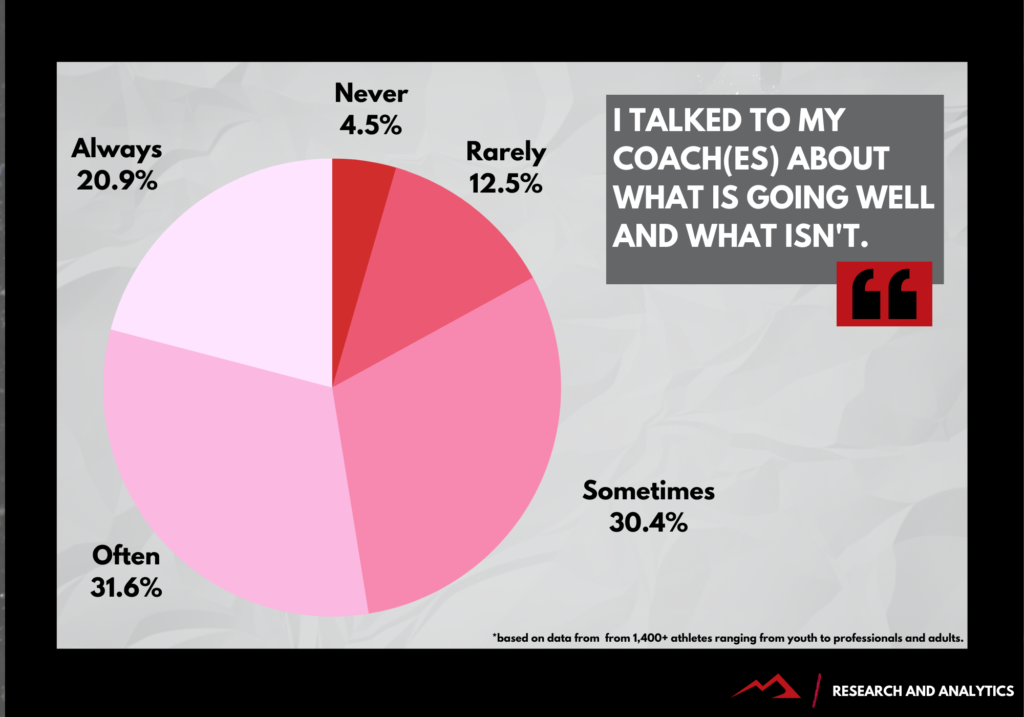It’s no secret that a coach has the power to create a lasting impact on the life of an athlete. Regardless of age, sport, or level, coaches often serve as a beacon in shaping the next generation, both on and off the field.
We’ve all had coaches that have left a positive impact on us and it’s commonly known that open and honest communication is critical for a coach when building meaningful relationships with athletes…through both the good and bad. Yet many athletes don’t always feel comfortable going to their coach to discuss successes and shortcomings, and some don’t at all.
With data from over 1,400 athletes ranging from youth and high schoolers to professionals and Olympians, Premier’s Research and Analytics team found that only 20.9% of athletes always talk with their coach about what’s going well and what isn’t. 62% of athletes spoke with their coach on the topic often or sometimes and 17% of athletes rarely or never spoke with their coach about what’s going well and what isn’t.

Talking to a coach about successes and shortcomings could mean on-field endeavors such as certain plays or skills, but also non-sport assets such as relationships and off-the-field experiences. It’s important to remember that each athlete is unique and perhaps has different wants and needs than their teammate across the locker room. It’s also important to remember that each coach has things that make them unique and different coaches find different ways to connect with athletes. Yet at the end of the day, a coach’s ability to foster an approachable, welcoming, and inclusive environment is critical when it comes to building strong team cohesion, regardless of level.
Struggling to connect with one of your players? Looking for new ways to strengthen team culture? Wanting to make sure you’re doing everything you can to make your team feel included? Here are a few ways to foster an environment where athletes are more likely to discuss successes and shortcomings with you and/or other coaches.
1. Schedule regular check-ins with your athletes.
Feedback and instruction in group settings can prove valuable, yet scheduling one-on-one time with your athletes is one of the best ways to foster open communication. Not only do one-on-ones create an environment where athletes are more likely to reflect and communicate, they show the athlete that you’re invested in their growth and development.
One-on-one’s also create a space for coaches to check in on the wellbeing of their athletes. All athletes (and humans) carry an invisible backpack filled with experiences, values, strengths, and weaknesses and the contents of that backpack shape an athlete’s experience in all assets of sport and life. It’s important to remember that all athletes are humans first and foremost, and that their successes on the field come second to overall well-being and personal development. Communicating this to your athletes is critical and one-on-ones create an excellent opportunity to do so.
2. Recognize that different athletes respond to different styles of coaching.
All coaches want to get the most out of their athletes, and being intentional about how you’re communicating with different athletes is one of the best ways to achieve that. While some athletes respond well to intense, hard-nosed coaching, others do not and respond poorly. Regardless of your coaching style, be sure to communicate that style with your athletes and ask them what they prefer when it comes to being at their best. Showing vulnerability by asking your athletes what they prefer lets them know that you care about their growth and that you genuinely want them to be their best…and that you want to play a part in that.
3. Acknowledge that different athletes go to different resources for different needs…and that’s okay.
Regardless of your role on a coaching staff, doing everything in your control to foster an inclusive and approachable environment is critical. Yet that doesn’t mean that everything has to go through you. Just like the varying personalities on a team, all coaches have unique qualities that resonate with varying individuals. One athlete may feel most comfortable talking to a certain coach about X’s and O’s on the field while a different athlete may go to that coach to speak about mental health and converse with a different coach about plays on the field.
One coach does not have to fulfill all the needs of their athletes, yet making sure there are resources available organization/team-wide are critical. Being sure to communicate to your team is essential towards creating an environment where athletes feel that they have the resources to succeed as an athlete and human being.
4. Take time during chaos to acknowledge and process with your team.
Things can get a bit chaotic for both coaches and players during the season…that’s normal, yet also quite stressful, considering that sport is just one component of an individual’s overall life. Taking time to acknowledge this can help foster a calm amongst the storm. Acknowledging the struggles lets your athletes know that you’re validating their experience and that you care about their worth as a unique individual on the team. Be sure to process emotions with the team in times of stress, but also in times of joy and neutrality to demonstrate that you’re committed to them getting the most out of their experience.
